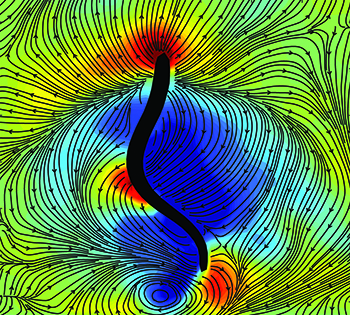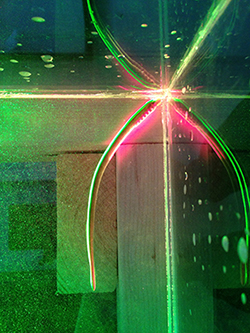How Does a Highly Efficient Swimmer Move? Jellyfish, Lamprey Study Reveals Surprising Forces At Play

Contacts: Tom Abate, Stanford Engineering
tabate@stanford.edu; 650-736-2245
Diana Kenney, Marine Biological Laboratory
dkenney@mbl.edu; 508-289-7139
STANFORD, Calif. and WOODS HOLE, Mass. − Millions of years ago, even before plate tectonics had nudged the continents into their current locations, jellyfish were already moving through the oceans using the same pulsing motions we observe today.
Now through clever experiments and insightful math, an interdisciplinary research team has revealed a startling truth about how jellyfish and lampreys, another ancient species that undulate like an eels, move through the water with unmatched efficiency.
This new understanding of motion in fluids appears in a Nature Communications article this week by engineer John Dabiri of Stanford University and three biologists who conduct collaborative research at the Marine Biological Laboratory (MBL) in Woods Hole, Mass.: Brad Gemmell of the University of South Florida, Sean Colin of Roger Williams University, and John Costello of Providence College. The biologists are adjunct scientists in the MBL’s Bell Center for Regenerative Biology and Tissue Engineering.
 Snapshot of a lamprey (black outline) swimming in a water tank at the MBL. Colors indicate low-pressure suction forces (blue) and high-pressure pushing forces (red) generated by the animal as it swims. Black lines and arrows indicate water flow directions around the animal. Credit: John O. Dabiri
Snapshot of a lamprey (black outline) swimming in a water tank at the MBL. Colors indicate low-pressure suction forces (blue) and high-pressure pushing forces (red) generated by the animal as it swims. Black lines and arrows indicate water flow directions around the animal. Credit: John O. Dabiri“It confounds all our assumptions,” said Dabiri, a professor of civil and environmental engineering and of mechanical engineering at Stanford. “But our experiments show that jellyfish and eels actually suck water toward themselves to move forward instead of pushing against the water behind them, as had been previously supposed.”
Dabiri and his collaborators have spent years studying the propulsion systems of jellyfish and lampreys. Both animals long ago evolved into efficient swimmers as judged by the remarkably high distance-to-effort ratio of their pulsing or undulating movements.
Studying nature for clues to improve human-made technologies is part of a field called biomimetics, and the interdisciplinary collaborators originally set out to seek insights that might inform the design of submarines, ships and the like.
About three years ago, Dabiri began to suspect that science fundamentally misunderstood underwater propulsion, that moving forward like nature’s best swimmers was far more complicated than spinning a propeller or kicking one’s feet to—in a manner of speaking—push off against the water behind.
Instead, they show that as a lamprey slithers along, it creates a pocket of low-pressure water inside each bend of its body. As the water ahead of the lamprey races into this low-pressure bend, the motion of that water pulls the lamprey forward.
Jellyfish propulsion is similar. As the jelly’s umbrella-shaped plume collapses, water ahead of the animal is pulled aft, propelling the jellyfish forward.
But how could this effect be proven?
To make their case, Dabiri and his collaborators designed an experiment that enabled them to use a 260-year-old equation that helps scientists to explain the theoretical behavior of fluids around solid objects, such as swimming animals.
This is tricky because solids and fluids are so different.
“Interactions between solid objects are usually straightforward, like two billiard balls bouncing off each other, and therefore you can calculate the forces without much difficulty,” Dabiri said. “But in a fluid every molecule is like a billiard ball and they are practically innumerable. There isn’t a simple way to calculate all those interactions.”
In 1755 mathematician Leonard Euler created an equation to describe fluid motion. It boiled down to the interplay of three variables: time, the rate of flow, and the pressure exerted by each molecule of the fluid on its neighbors. Time and flow were easy to measure even then. But pressure is much more difficulty to measure, especially as an animal swims through the fluid.
So Dabiri’s team created an experimental system (see sidebar below) that enabled them to accurately approximate this pressure variable, and it was on this achievement that paper rests.
“Everyone appreciates that Euler’s equation can effectively describe the fluid motion, but extracting the pressure from the equation in real-world experiments [had] been a longstanding challenge,” Dabiri said.
“We’ve been measuring the velocity of fluid around swimming jellyfish in our MBL lab for years. It’s John Dabiri’s code to measure pressure that is really innovative in this paper,” said co-author Sean Colin. “That is key, because it allows us to measure the forces around the body and where they are generated. This led us to see the animals aren’t pushing themselves: they are pulling themselves. It took us a long time to convince ourselves that this was really happening.”
The next steps are to use this newfound knowledge to revisit efforts at biomimetic design of underwater vehicles.
“For nearly 100 years, it has been assumed that mimicking natural swimming meant finding ways to generate high pressures to push water backwards for thrust,” Dabiri said. “Now we realize we’ve had it backwards, and so the search is on for ways to generate low pressure suction in order to achieve more efficient underwater propulsion.”
Costello, a jellyfish expert, said the new findings show the mechanism selected by evolution to optimize distance-for-effort in underwater animals.
“Animals that move in fluids almost invariably use flexible, rather than rigid, propulsive structures,” he said. “This work opens the door to understanding why evolution has converged upon particular bending patterns.”
Adapted from materials provided by Stanford Engineering.
Citation:
Gemmell BJ, Colin SP, Costello JH and Dabiri JO (2015) Suction-based propulsion as a basis for efficient animal swimming. Nature Communications: DOI: 10.1038/ncomms9790
Sidebar
Visualizing Fluid Motion
To surmount the challenges of measuring fluid motion around the animal as it swims, the team used a technique called high-speed digital particle image velocimetry (DPIV).
 A lamprey swimming in the corner of a water tank at MBL while illuminated by green and red laser sheets. Reflections in the corner of the water tank give the appearance of multiple lampreys.
A lamprey swimming in the corner of a water tank at MBL while illuminated by green and red laser sheets. Reflections in the corner of the water tank give the appearance of multiple lampreys.Credit: Sean P. Colin
They started at the MBL with a rectangular, acrylic tank about one foot wide, four feet long and 6 inches deep. In the water floated millions of tiny hollow glass beads that served as proxies for water molecules. They positioned two lasers opposite one another on the thin sides of the rectangle, with a high-speed digital camera set alongside each laser. Lampreys were provided by MBL Associate Scientist Jennifer Morgan, who studies spinal cord regeneration in the species.
As small jellyfish and lamprey swam through the tank their motions perturbed the glass beads, whose positions were tracked by the lasers and recorded by the digital cameras in fractions of a second. The experiment then became an exercise in computation.
Time and rate of flow could be precisely measured for the beads, at each moment. Making thousands upon thousands of calculations, the team used these two precise variables to solve for the third, elusive variable in the fluid flow equation: pressure of each fluid molecule upon its neighbors. They fed these results into a computer that transformed the mountain of data into a visual representation of the pressure forces at play. From this image, it became clear that the low-pressure pockets created on the inside edge of each undulating animal movement were the dominant driver of propulsion.
As an added proof, the researchers compared two batches of lampreys of the same species. The control batch moved in natural, undulating fashion. The experimental batch were surgically modified with a spinal cord incision so that only their tail end flicked, using a less efficient kicking motion, not unlike human swimmers. “We were interested in seeing how less-than-optimal body movements affected the hydrodynamics of swimming,” Colin said.
“The body undulations of the normal lampreys set them apart as much better swimmers than you and me,” Dabiri said. “Human swimmers generate high pressure instead of suction. That’s good enough to get you across the pool, but requires much more energy than the suction action of eels and jellyfish.”
—###—
The Marine Biological Laboratory (MBL) is dedicated to scientific discovery and improving the human condition through research and education in biology, biomedicine, and environmental science. Founded in Woods Hole, Massachusetts, in 1888, the MBL is a private, nonprofit institution and an affiliate of the University of Chicago.